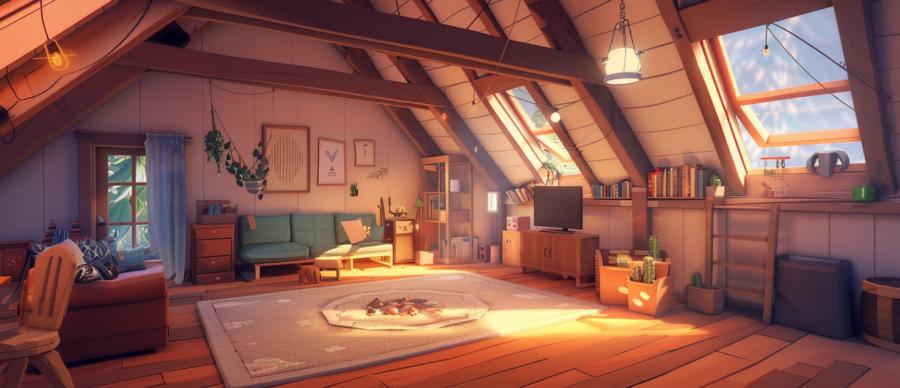Fortunately, there are smart, slightly sneaky ways to gain usable space without hauling out the blueprints or convincing your municipality you’re not starting a compound.
Rethink the Basement: Not Just for Forgotten Treadmills
Basements have long served as the final resting place for obsolete technology and the occasional Halloween bin. But with a modest investment in insulation, lighting, and some waterproofing, you can turn yours into an actual, breathable space.Home offices, media dens, or a guest suite that’s just far enough away from the main floor to let visitors think they’re staying in a separate reality—all doable.
Just don’t forget egress windows if you’re planning anything more sophisticated than a storage cave. Not only is it a safety thing, it also keeps you on the right side of building codes. Nothing kills the vibe of a new basement lounge like a visit from a fire marshal holding a clipboard.
Attics Aren’t Just for Ghosts Anymore
That triangular space above your head might be more than an air trap for warm regrets and lost socks. If your attic has the right headroom (at least 7 feet in 50% of the space), you’re sitting on a goldmine of potential.Think reading nook with skylights, art studio, or a child’s bedroom where they can finally pretend they’re Harry Potter without anyone sleeping in a cupboard.
Insulation is critical here. An unconditioned attic can cook in summer and freeze in winter, which is only charming in rustic novels. Add in proper ventilation, flooring, and lighting, and your attic stops being a horror movie set and starts being a usable extension of your home.
Garages: From Oil Stains to Office Space
Converting your garage into a livable room is one of the fastest ways to cheat the square footage gods. Got a two-car garage but only one car and a deep emotional connection to your lawnmower? Time to relocate the lawn tools and take back that territory.Modern garage conversions can include mini-split HVAC systems, soundproofing, and even insulated overhead doors that look like they belong in Architectural Digest instead of a mechanic’s waiting room.
Whether it becomes a music room, a teenage hideaway, or your new home office (that isn’t also your kitchen counter), it’s a serious upgrade—no permit required in many cases, though you should still check local regulations.
Porch Enclosures: Walls That Pay for Themselves
Your porch may already have a roof, which puts you halfway to a new sunroom. Enclosing it with windows and insulated walls can give you a new sitting room, workout space, or breakfast nook with natural light that doesn’t ask questions about your life choices.It’s a way to expand your living area while technically not increasing your home’s footprint. Even better? You get to enjoy the outdoors without the insects, humidity, or the neighbor who insists on mowing at 6 a.m.
Just make sure to use weather-rated materials. There’s nothing worse than a cozy retreat that turns into a mold diorama by spring.
Walls Optional: Open-Plan Tweaks That Work
Sometimes, gaining space is less about adding more square footage and more about using what you already have smarter. Open-plan designs have been trendy for years, but what’s really exciting is the rise of flexible zoning.Instead of committing to a full demolition, try **folding partitions**, sliding panels, or double-duty furniture that changes with your needs. A bookshelf wall can separate a work area from the living room. A rolling island in the kitchen becomes a bar cart or homework table.
There’s real magic in modularity—plus, it’s cheaper than therapy after living in cramped quarters for too long.
Closet Conversions That Actually Make Sense
Every home has at least one closet that’s doing absolutely nothing. Maybe it houses two winter coats, a vacuum from 2008, and a box labeled “random wires.” These small, enclosed spaces can do a lot more than hide your cable shame.By adding lighting, ventilation, and a touch of imagination, a closet can become a mini home office, a crafting cove, or even a meditation spot (if you’re into breathing deeply in confined spaces). For smaller homes, this kind of micro-zoning can have a surprisingly big psychological impact—like gaining an entire wing, but for people under 6 feet tall.
And if you ever want it back as a closet, just reverse the process. It’s the home design version of a ctrl+z.
Stairway Nooks That Pull Their Weight
The space beneath your staircase doesn’t have to be a vacuum for shoes, umbrellas, and mild shame. With some clever carpentry, it can become:- A reading nook complete with shelves and a sconce
- Pull-out drawers for hidden storage
- A mini playhouse for kids or, if you’re honest with yourself, adults
Furniture That Works Harder Than You Do
Sometimes, your floor plan isn’t the problem—your furniture is just lazy. Multi-use furniture is a godsend in homes short on breathing room.- Murphy beds that fold into desks
- Ottomans with cavernous storage inside
- Dining tables that expand like transformers at Thanksgiving
Backyard Buildings That Don’t Break the Bank
Technically not additions *to* your house, detached structures like garden studios, prefab sheds, and backyard offices are becoming more common—and more creative.You can get pre-insulated models delivered and assembled in a matter of days, and they often don’t require full-blown permits depending on your location and their size. They’re perfect for work, art, or just having a space to sit and remember what silence sounds like.
Plus, if you ever decide to write a novel, teach virtual yoga, or finally learn to paint, these little buildings will be waiting—quietly judging your procrastination.
More Room, Less Doom
Expanding your usable living space doesn’t have to mean financing a second mortgage or bribing zoning officials with cookies. With a little planning and some honest self-inventory (do you really need three crockpots?), you can rework what you already have into something that feels new.Creativity tends to thrive under constraint—and so does good design. Whether you’re transforming a basement into a speakeasy-style movie room or turning the coat closet into a meditation nook that doubles as escape from your children, there’s space in your house you haven’t met yet.
It’s not about building more. It’s about finally using what’s been hiding in plain sight.
Article kindly provided by patriotpropertypros.com


